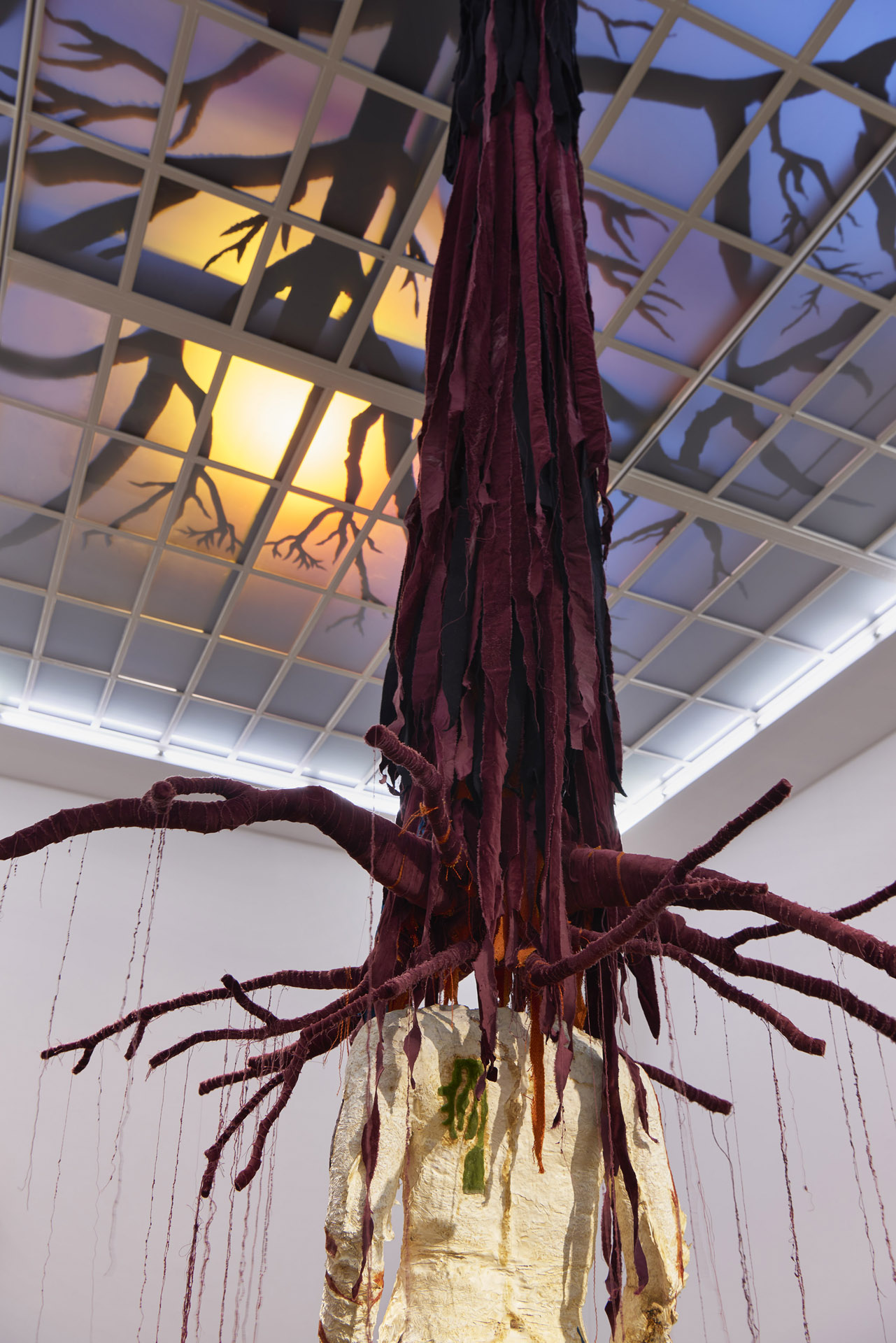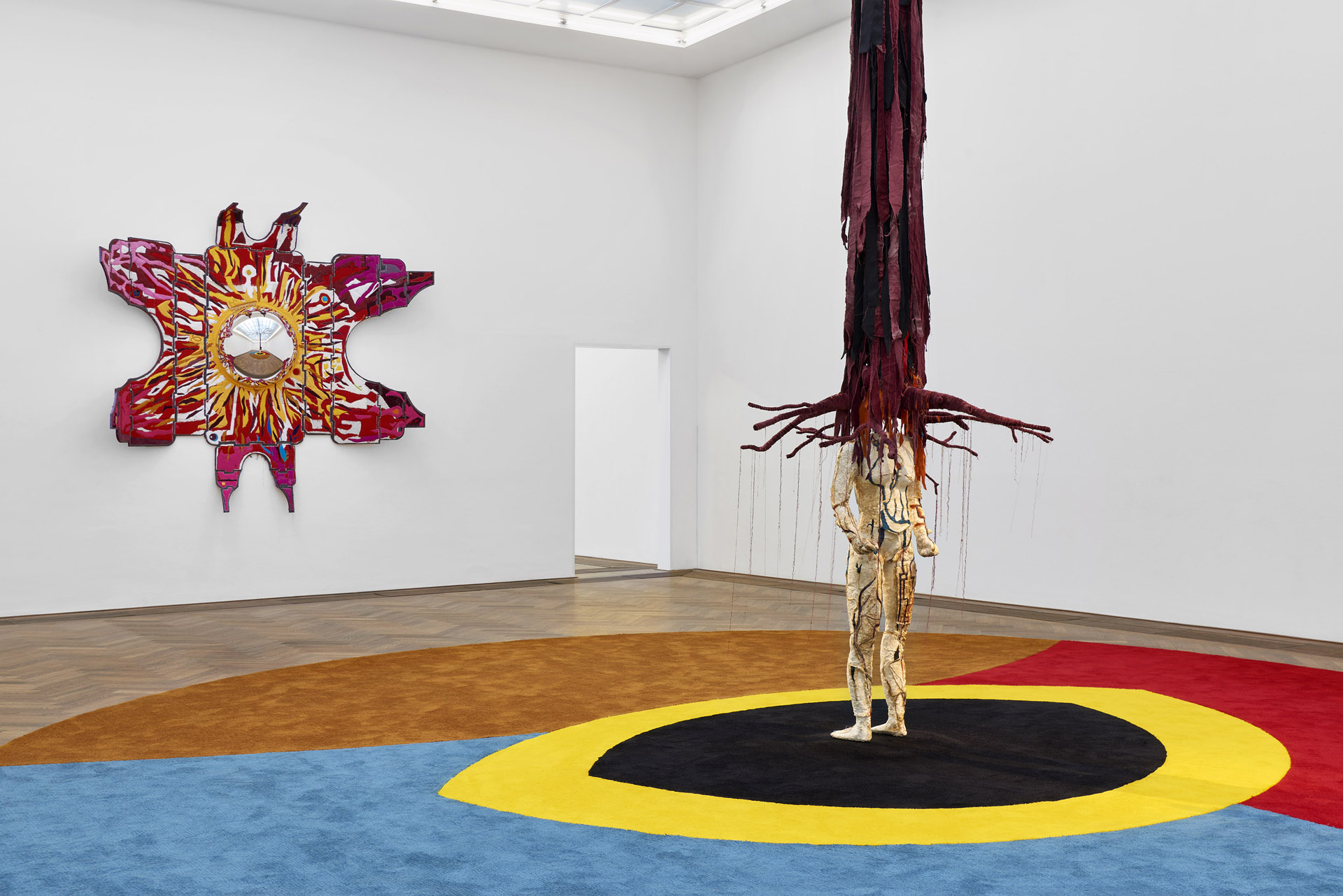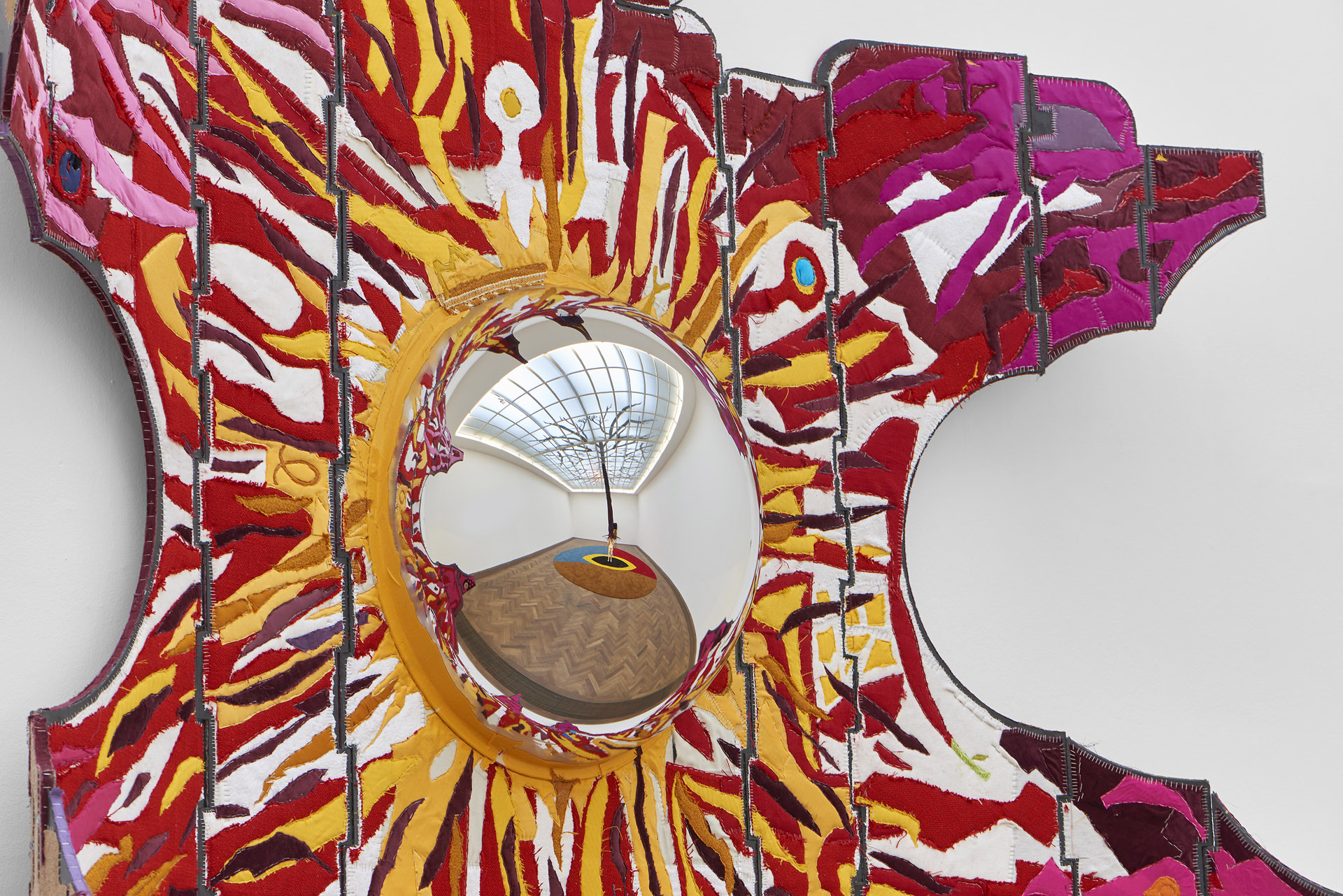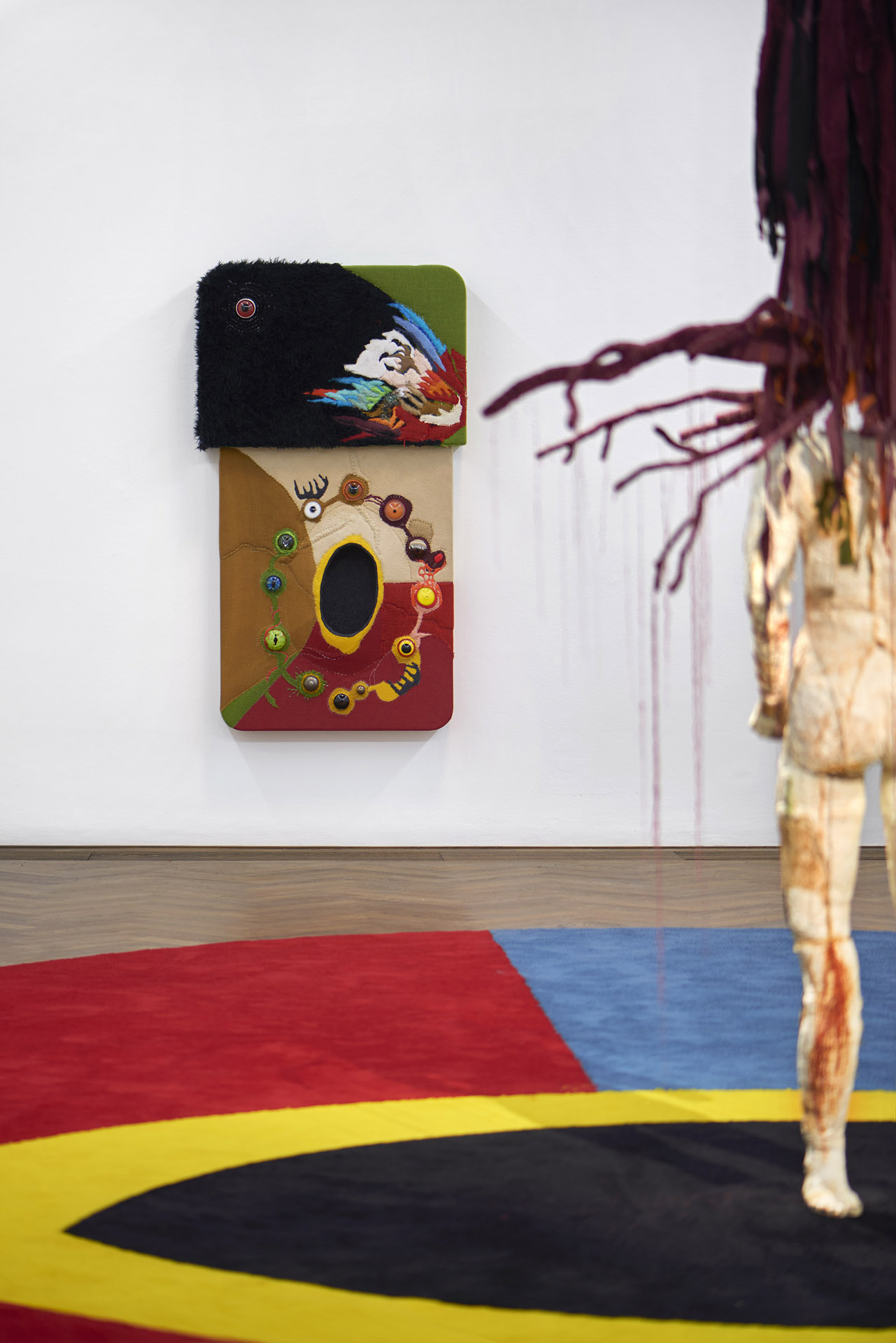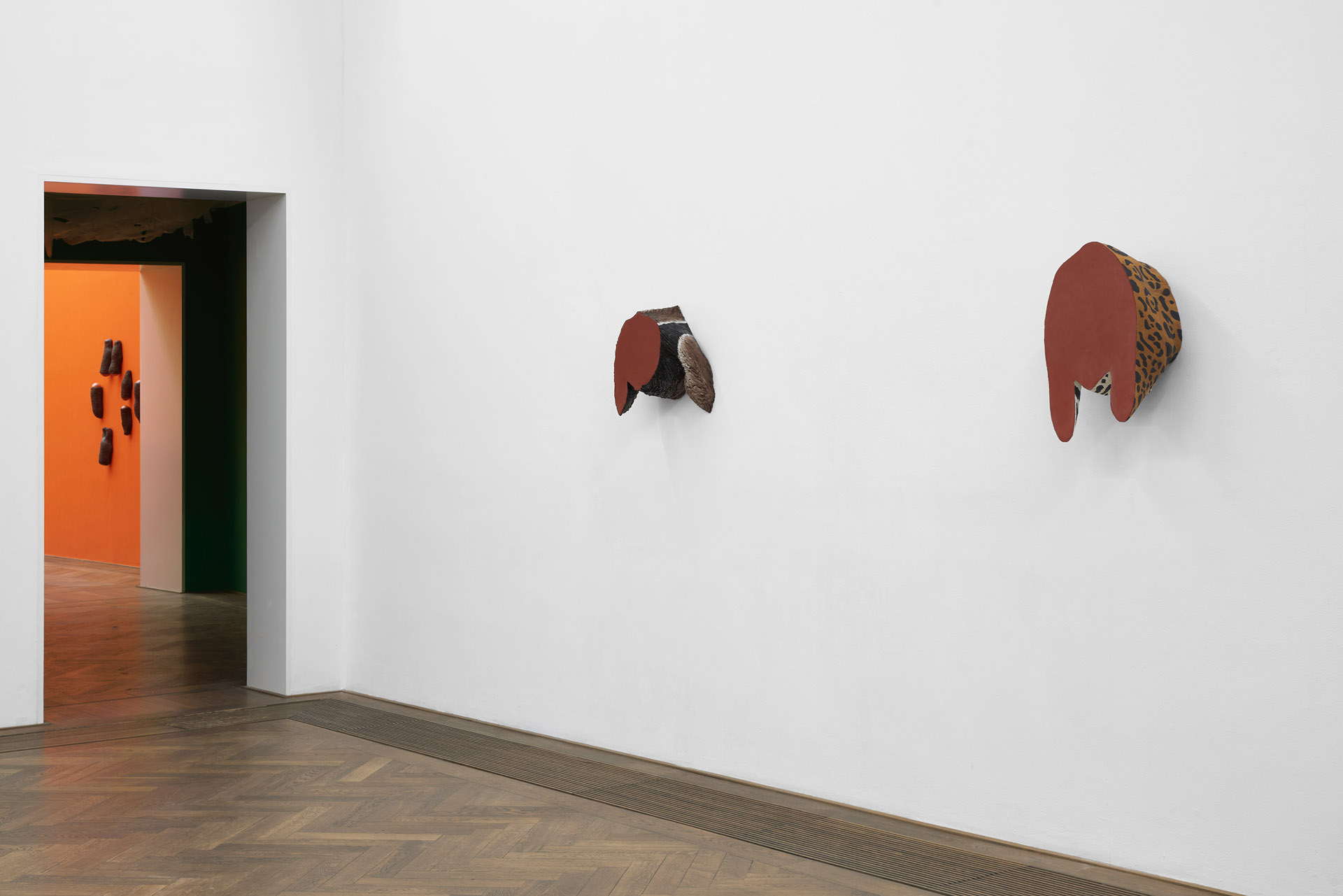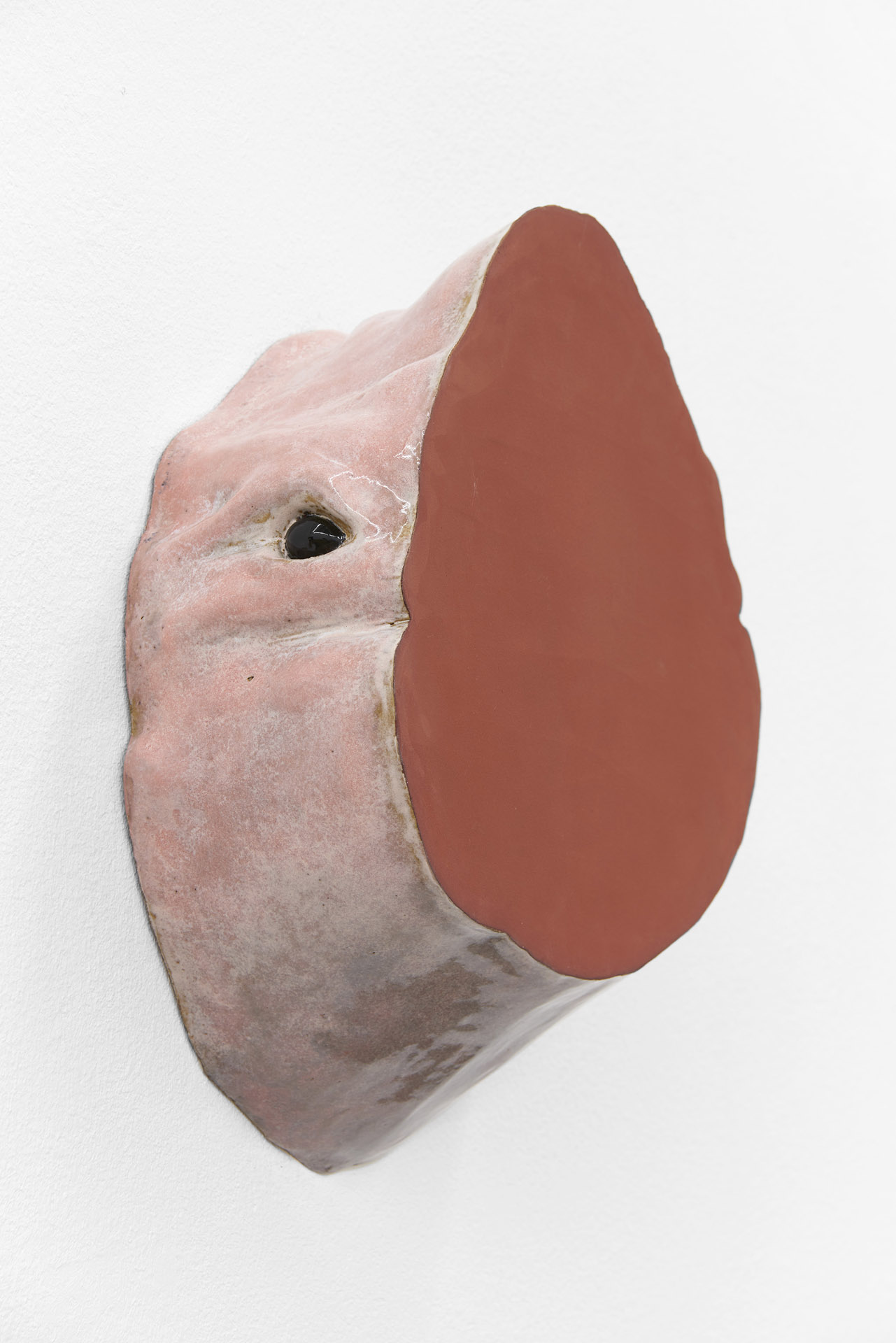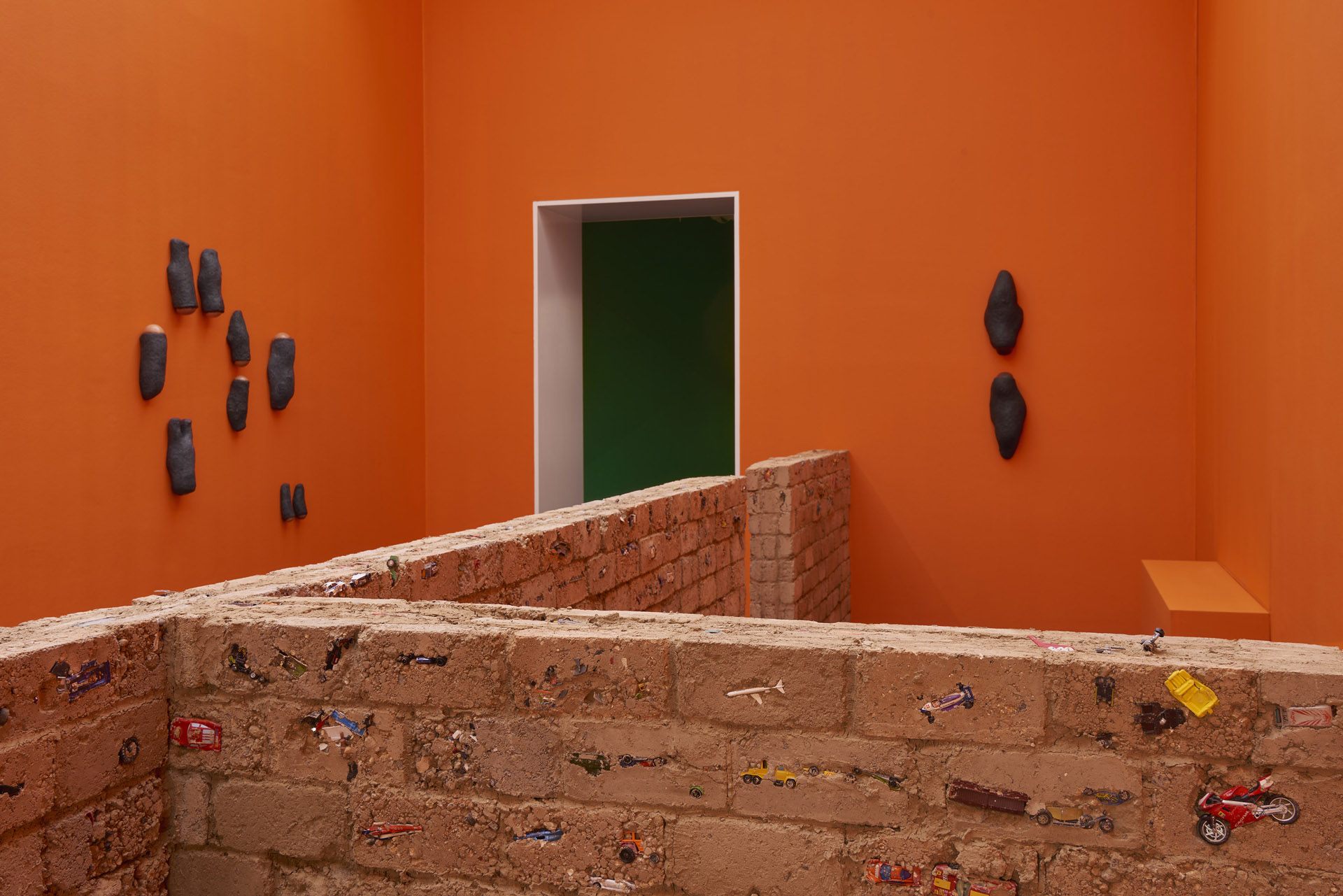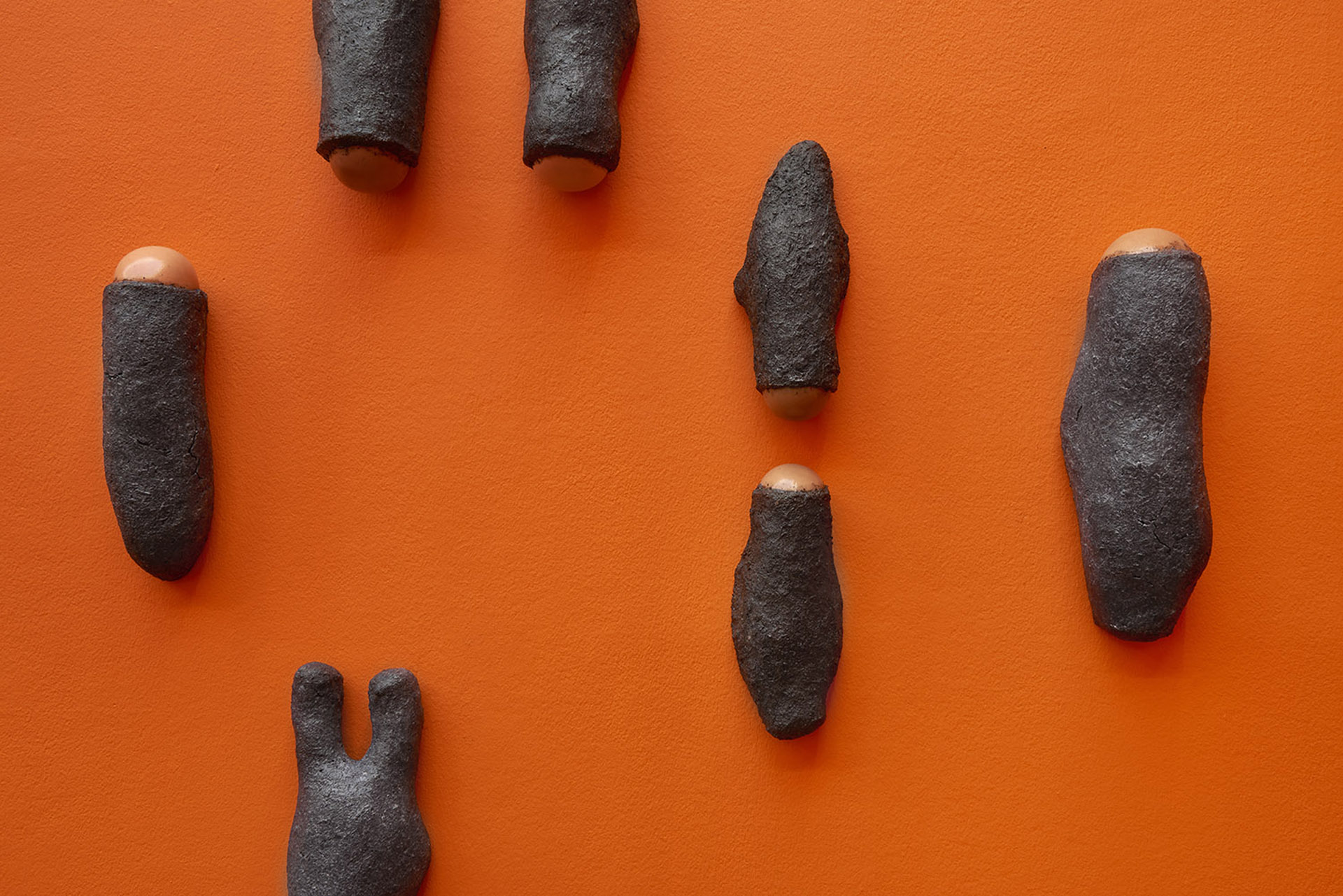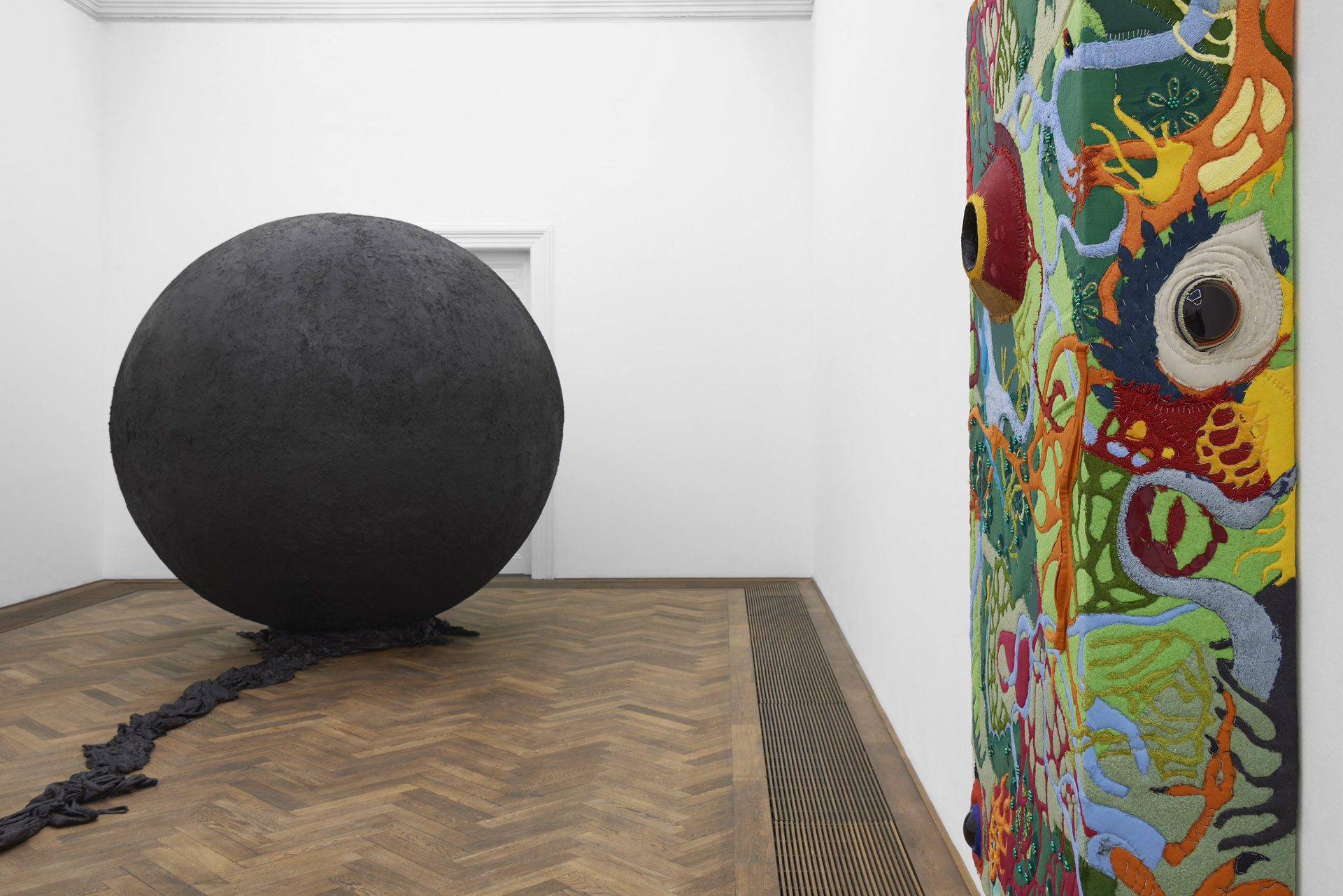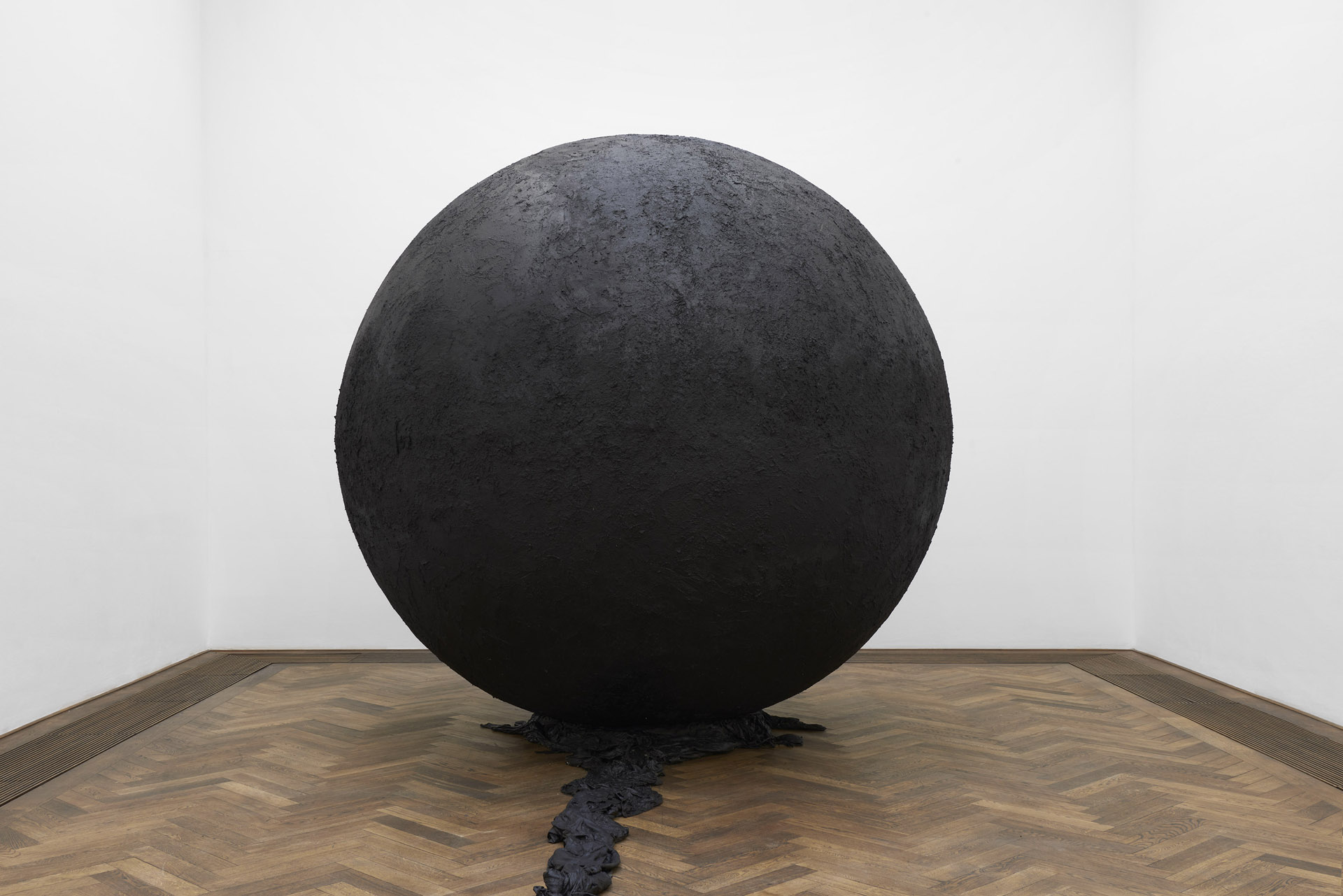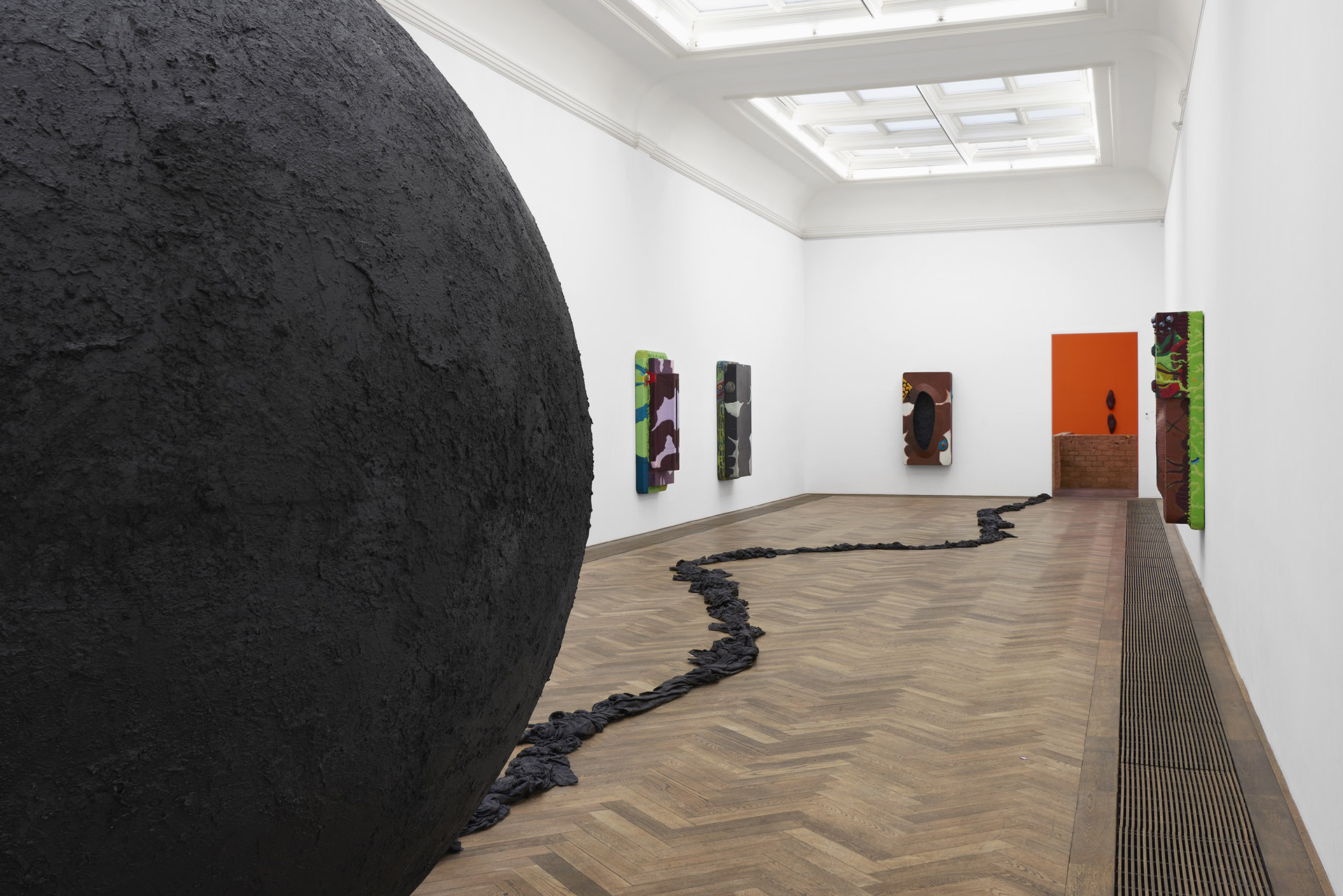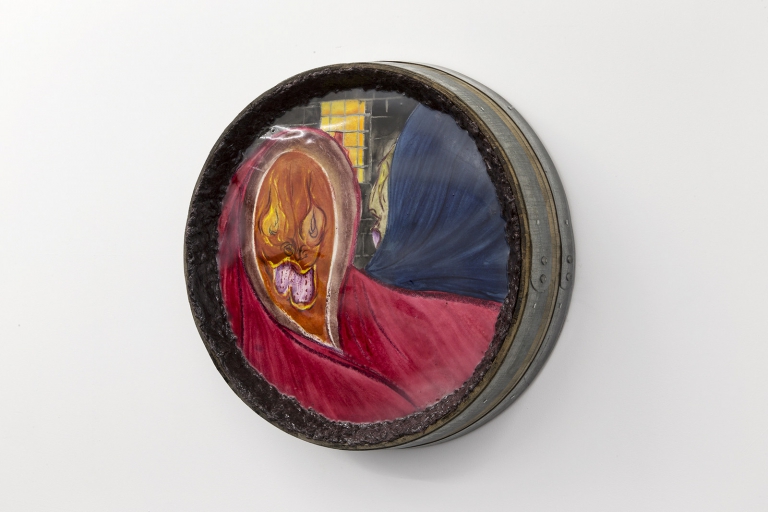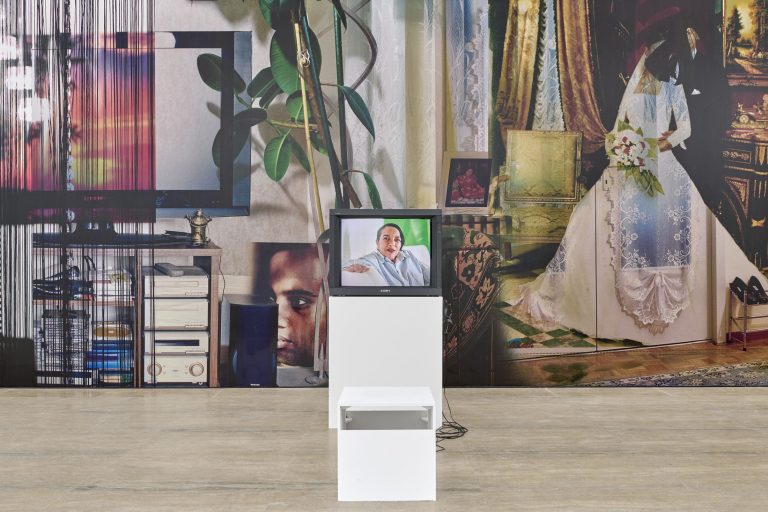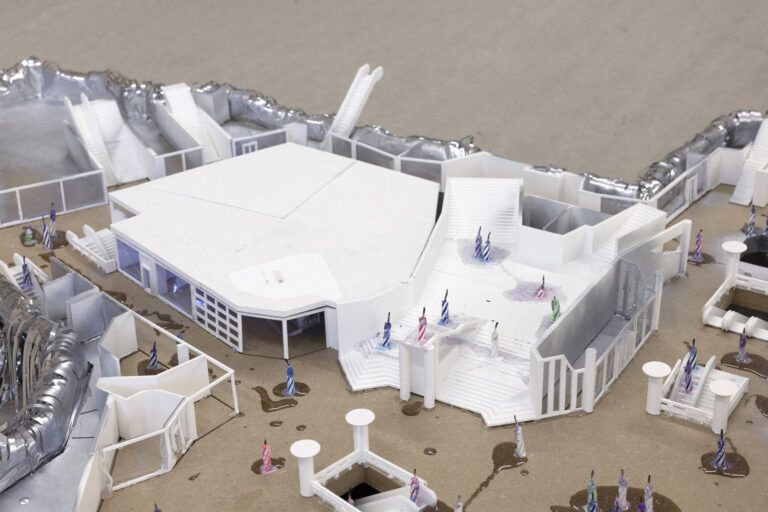Artist: Pedro Wirz
Exhibition title: Environmental Hangover
Venue: Kunsthalle Basel, Basel, Switzerland
Date: January 21 – May 1, 2022
Photography: images courtesy the artist and Kunsthalle Basel
Standing at the entrance to Pedro Wirz’s exhibition, the view is blocked. Obstructing one’s line of sight is a giant spherical sculpture whose craggy surface is covered in asphalt—a petroleum by-product primarily known as material used for paving and roofing. Emerging from it like a serpent’s shed skin is a path of strewn clothing soaked in the once-liquid bitumen that was left to dry and harden in a shape roughly following the route of the BR-230, the Trans-Amazonian Highway. Inaugurated in the 1970s under Brazil’s military dictatorship, the circa 4,000 km-long highway runs through the middle of the world’s largest contiguous tropical forest and has, directly or indirectly, caused vast deforestation with immense ecological consequences. Further into the space, wall sculptures flaunt wild abstractions that upon closer inspection reveal themselves to be representations of flora and fauna. They are crafted from scraps of discarded blankets, towels, and other textiles combined with large glass eyes; the whole upholstered onto wooden frameworks shaped like larger-than-life smartphones whose rounded corners and oblong shapes are ubiquitous in contemporary urban landscapes. Notice as well the placement of the glass eyes, for example at an edge where a camera eye or volume button might be placed on a digital device. These details, like the strangely ominous orifices (Nest entrances? Wounds? Mouths? Anuses?) that puncture most of these works, tethers their imaginary equally to the organic and to the technological.
As an opener, the works in the first room serve as both an allegory of a profit-driven planet smothered by an ecological crisis and as a warning about the contradictory nature of “progress.” It sets the tone for an exhibition that deploys a complex materiality and elaborate craftwork to evoke a world that desires purity in nature, but also covets technological “advancements;” a world aspiring to eco-responsibility, but also relishing its branded take-out coffee and latest-model digital device.
For this, Wirz’s largest institutional exhibition to date, the Brazilian Swiss artist has created an impressive number of new sculptures and installations, their materiality and motifs drawn equally from organic matter and consumer culture. The clash of the two being the dominant preoccupation in his life trajectory. Before leaving behind a communications job in a toxic landfill to attend art school in Basel, Wirz spent most of his youth in the tropical region of the Paraíba Valley, Brazil. And he often locates his inspirations in the region’s massively changing ecologies, demographics, mythologies, and superstitions. Raised by an agronomist who worked with soil substrates and a biologist who conducted research into the effects of polluted water on the DNA of amphibian life within the region, the artist is fascinated in equal measure by hard science and by folklore. The latter uses fear, awe, and mystery to articulate those aspects of the natural world that cannot be answered to by way of rational knowledge. What Wirz has constructed from these twinned interests, then, are materially dense unravelings of time and space, each built up from intricate backstories that trace the interconnected trajectories of colonialism, extractive economies, technological advancement, social codification, climate change, species extinction, and the myths that attempt to make sense of them. Wirz puts his finger into these wounds and sculpts from them. The result is a commentary as fantastical as it is sobering regarding the current state of the world.
Leave the Trans-Amazonian Highway to approach a maze of brick walls made of rammed earth, a method of construction that has been in use for thousands of years. Like geological strata, the uppermost layers show this earth mixed with miniature cars, trucks, planes, and rocket ships—playfully visualizing the start of significant human impact on the earth’s ecosystems known as the Anthropocene, and naturally including our present. Sedimen-ted in them are toys that initiate children’s (principally boys’) socialization to value mobility, power, and consumption. Larvae-like forms hang on the room’s deep orange walls, each sculpture made from plastic infant dolls wrapped in clothing before being encrusted in a mixture of soil and acrylic paste. More relics of childhood (these rather connected to girls’ identity formation), which in this case initiate socialization to value reproduction and caretaking. The series title hints at the need to rebalance our social order: Sour Ground refers to acidic pH levels of soil exacerbated by pollution that thus becomes a hostile habitat for the growth of certain lifeforms.
Anchoring the third room, a large egg-like sculpture built from strands of the fibre cement known as Eternit evokes a wasp’s nest or swollen womb. Or, alternatively, an alien sleeping pod, a resemblance underscored by its glistening, almost metallic grey color. A smaller wall work, yet again in the form of some sort of cocoon or refuge, is similarly constructed from the building material made famous by Swiss industrial designer Willy Guhl in the 1950s and ‘60s in his attempt to bring futurist looking mid-century modern design to the masses. Overhead, the artist uses an expanse of cut and torn plastic to conjure the phenomenon of the “flying river,” an air-borne vapor mass that floats above the Amazonian Forest and is integral to the whole planet’s climatic regulation: the lifeblood of nature.
Spare and almost solemn, the fourth space features a series of ceramic wall sculptures that represent endangered (or likely soon to be endangered) species of the Amazonian rain-forest, biological and mythological. Their sliced, dismembered bodies lament the decline of biodiversity in the natural and supernatural world. The artist hangs these works like decorative wall trophies, a gesture at once critical, devastating, and poignant.
Central to the last room of Wirz’s exhibition is an installation based on Curupira, a mythical figure of Brazilian folklore. This spirit of the forest whose feet point backward (leading the ill-intentioned astray) here also confuses categories with its combination of male and female sexual characteristics. The creature stands, with a tree in place of its head, its branch-like extensions seemingly reaching upwards through and across the skylit ceiling of the space. These limbs are made out of recycled clothing and textile waste, while the body of the sculpture is built out of agricultural waste and a mycelium culture, fungus that researchers hope will become a viable natural substitute for concrete in the future. The piece is, like so much in Wirz’s oeuvre, a marriage of legend and science, nature and culture, materiality and imagination.
Like a coda to the dire world in which he has immersed us, the final work in the exhibition bears hinged winged elements that close around a central convex mirror, recalling at once a technoid exoskeleton, an extravagant flower, a baroque altarpiece, and, perhaps most directly, Jan van Eyck’s iconic The Arnolfini Portrait of 1434. It is said that the fascination for convex mirror devices in 15th century paintings was to establish a moral comparison between the imperfect world of the viewer and the idealized world of virtue reflected in the painted mirror. Having reached the end of the exhibition, you stand before and are reflectively captured in the work’s curvature. It is the companion piece to the blackened globe that you met at the entrance; if that one blocked your view, by the time you get to the end of the show, your horizons have broadened. And while there is nowhere to hide from the all-seeing eye of Wirz’s mirror, there is also no contrasting world of virtue. And yet, with hope, humor, and warmth, the artist has reminded us all along that everything is not yet lost. As his exhibition title Environmental Hangover hints, with any hangover, we must pay for the toxins we’ve ingested, but at least our livers are still doing the work to clear them out of our system. Yes, a hangover hurts, it reprimands, but it is also the body’s appeal for us to do better.
Installation view, Pedro Wirz, Environmental Hangover, Kunsthalle Basel, 2022, view on Chapéu Telúrico, 2022. Photo: Philipp Hänger / Kunsthalle Basel
Installation view, Pedro Wirz, Environmental Hangover, Kunsthalle Basel, 2022, view on Flor Satélite, 2022 (left), Chapéu Telúrico, 2022 (right), Ovo Espacial, 2022 (floor). Photo: Philipp Hänger / Kunsthalle Basel
Installation view, Pedro Wirz, Environmental Hangover, Kunsthalle Basel, 2022, view on Flor Satélite, 2022. Photo: Philipp Hänger / Kunsthalle Basel
Installation view, Pedro Wirz, Environmental Hangover, Kunsthalle Basel, 2022, view on Chapéu Telúrico, 2022, and Ovo Espacial, 2022 (floor). Photo: Philipp Hänger / Kunsthalle Basel
Installation view, Pedro Wirz, Environmental Hangover, Kunsthalle Basel, 2022, view on Coro de Princesa (Amarelão), 2022 (left), Chapéu Telúrico, 2022 (right), Ovo Espacial, 2022 (floor). Photo: Philipp Hänger / Kunsthalle Basel
Installation view, Pedro Wirz, Environmental Hangover, Kunsthalle Basel, 2022, view on Bicho Abstrato (Tamanduá), 2022 (left), und Bicho Abstrato (Onça), 2022 (right). Photo: Philipp Hänger / Kunsthalle Basel
Installation view, Pedro Wirz, Environmental Hangover, Kunsthalle Basel, 2022, view on Bicho Abstrato (Boto-cor-de- rosa), 2022. Photo: Philipp Hänger / Kunsthalle Basel
Installation view, Pedro Wirz, Environmental Hangover, Kunsthalle Basel, 2022, view on Bicho Abstrato (Iara), 2022. Photo: Philipp Hänger / Kunsthalle Basel
Installation view, Pedro Wirz, Environmental Hangover, Kunsthalle Basel, 2022, view on Untitled (Nest), 2022 (left), Bela Peça, 2022 (right), Corpo Seco, 2022 (ceiling). Photo: Philipp Hänger / Kunsthalle Basel
Installation view, Pedro Wirz, Environmental Hangover, Kunsthalle Basel, 2022, view on Our cities are made to be destroyed, 2016–2022 (front) and the series Sour Ground, 2022 (back). Photo: Philipp Hänger / Kunsthalle Basel
Installation view, Pedro Wirz, Environmental Hangover, Kunsthalle Basel, 2022, view on the series Sour Ground, 2022. Photo: Philipp Hänger / Kunsthalle Basel
Installation view, Pedro Wirz, Environmental Hangover, Kunsthalle Basel, 2022. Photo: Philipp Hänger / Kunsthalle Basel
Installation view, Pedro Wirz, Environmental Hangover, Kunsthalle Basel, 2022, view f. l. t. r. on Exúvia, 2022, Coro de Princesa (Sumaúma), 2022, Coro de Princesa (Seringa), 2022, Coro de Princesa (Envira Preta), 2022. Photo: Philipp Hänger / Kunsthalle Basel
Installation view, Pedro Wirz, Environmental Hangover, Kunsthalle Basel, 2022, view on Exúvia, 2022 (left), and Coro de Princesa (Sumaúma), 2022 (right). Photo: Philipp Hänger / Kunsthalle Basel
Installation view, Pedro Wirz, Environmental Hangover, Kunsthalle Basel, 2022, view on Exúvia, 2022. Photo: Philipp Hänger / Kunsthalle Basel
Installation view, Pedro Wirz, Environmental Hangover, Kunsthalle Basel, 2022. Photo: Philipp Hänger / Kunsthalle Basel


